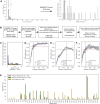Ontology-guided clustering enables proteomic analysis of rare pediatric disorders
- PMID: 40425748
- PMCID: PMC12254340
- DOI: 10.1038/s44321-025-00253-z
Ontology-guided clustering enables proteomic analysis of rare pediatric disorders
Abstract
The study of rare pediatric disorders is fundamentally limited by small patient numbers, making it challenging to draw meaningful biological conclusions. To address this, we developed a framework integrating clinical ontologies with proteomic profiling, enabling the systematic analysis of rare conditions in aggregate. We applied this approach to urine and plasma samples from 1140 children and adolescents, encompassing 394 distinct disease conditions and healthy controls. Using advanced mass spectrometry workflows, we quantified over 5000 proteins in urine, 900 in undepleted (neat) plasma, and 1900 in perchloric acid-depleted plasma. Embedding SNOMED CT clinical terminology in a network structure allowed us to group rare conditions based on their clinical relationships, enabling statistical analysis even for diseases with as few as two patients. This approach revealed molecular signatures across developmental stages and disease clusters while accounting for age- and sex-specific variation. Our framework provides a generalizable solution for studying heterogeneous patient populations where traditional case-control studies are impractical, bridging the gap between clinical classification and molecular profiling of rare diseases.
Keywords: Pediatrics; Plasma; Proteomics; SNOMED CT; Urine.
© 2025. The Author(s).
Conflict of interest statement
Disclosure and competing interests statement. MM is an indirect shareholder in EvoSep Biosystems. The remaining authors declare no competing interests.
Figures









References
-
- Albrecht V, Müller-Reif JB, Mann M, Brennsteiner V (2025) A simplified perchloric acid workflow with neutralization (PCA-N) for democratizing deep plasma proteomics at population scale. Preprint at 10.1101/2025.03.24.645089
-
- Benjamin RJ, McLaughlin LS (2012) Plasma components: properties, differences, and uses. Transfusion 52:9S–19S - PubMed
MeSH terms
Substances
Grants and funding
LinkOut - more resources
Full Text Sources
Medical
Miscellaneous

